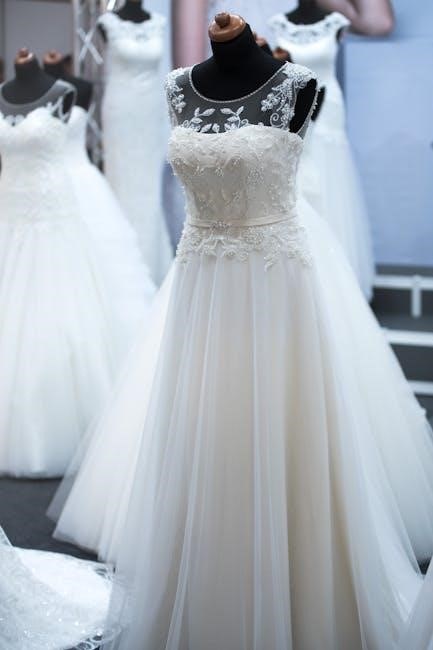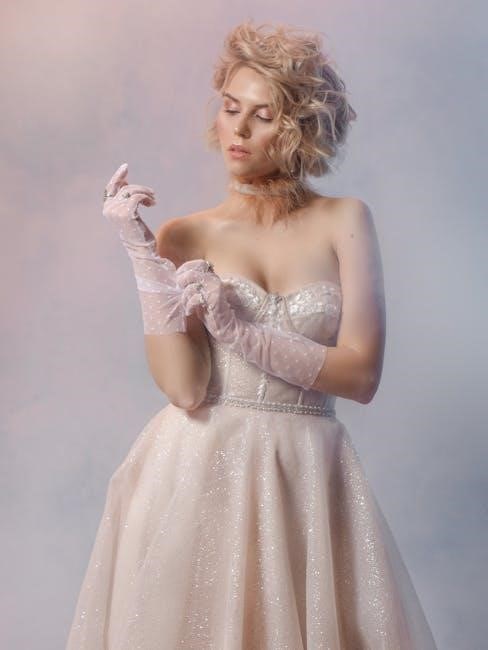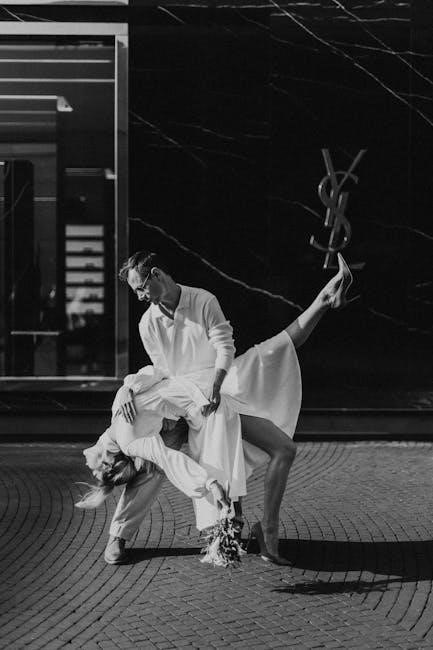Your wedding dress size guide is essential for ensuring a perfect fit. It helps you navigate measurements, size charts, and style options, guaranteeing confidence on your big day.
Why Finding the Right Wedding Dress Size Matters
Finding the right wedding dress size is crucial for both confidence and beauty on your big day. A proper fit ensures comfort and allows for effortless movement, while also enhancing your overall appearance. Ill-fitting gowns can restrict movement or look unflattering, potentially ruining the magical experience. Since every bride’s body is unique, understanding how bridal sizing works is key to making informed decisions. Accurate measurements and comparing them to size charts help you find a dress that flatters your silhouette and makes you feel stunning.

How to Measure Yourself for a Wedding Dress
Use a flexible tape measure and wear proper undergarments. Measure bust, waist, hips, and hollow to waist. Stand straight and check in a mirror for accuracy.
Key Measurements: Bust, Waist, and Hips
Accurate measurements of your bust, waist, and hips are crucial for a perfect wedding dress fit. Measure your bust under the arms at its fullest point. Your natural waist is the narrowest part of your torso, typically above the belly button. Hips are measured around the widest section, usually 7-9 inches below the waistline. These measurements form the basis for comparing with bridal size charts, ensuring a flattering and comfortable fit for your wedding day.
How to Measure the Hollow to Waist
To measure the hollow to waist, start by standing upright. Locate the hollow of your neck, just below the Adam’s apple. Place the tape measure at this point and draw it straight down to your natural waistline, which is the narrowest part of your torso. This measurement determines the length of your wedding dress and ensures proper fit, especially for styles like mermaid or trumpet dresses. Take the measurement over undergarments for accuracy, as this will affect how the dress drapes and fits.
Understanding Wedding Dress Size Charts
Wedding dress size charts vary by designer and region, differing from standard clothing sizes. They provide measurements for bust, waist, and hips to ensure the best fit.
How Designer Size Charts Differ
Designer wedding dress size charts vary significantly due to differing measurement standards and design aesthetics. Each designer tailors their sizing to fit their unique styles, body types, and target audiences. Some may cater to specific silhouettes or body shapes, while others offer custom sizing for a more personalized fit. These variations mean that a size 8 in one designer’s collection may equate to a size 10 or 12 in another’s. This inconsistency highlights the importance of consulting the specific designer’s chart and considering professional measurements for an accurate fit;
Comparing Bridal Size Charts Across Designers
Comparing bridal size charts across designers is crucial for finding your perfect fit. Each designer has unique sizing standards, reflecting their target audience and design approach. Some may cater to petite or plus-size brides, while others focus on specific silhouettes. To compare effectively, use a universal measurement guide and check how each designer’s chart aligns with your body measurements. Tools like size conversion charts or retailer assistance can help bridge the gap between differing sizing systems, ensuring you select the right size for your chosen gown.
Bridal Sizing vs. Regular Clothing Sizes
Bridal sizing often differs from regular clothing sizes, with gowns running smaller. Always order 2-3 sizes larger than your street size for the best fit.
Why Bridal Sizes Often Run Smaller
Bridal sizes often run smaller than regular clothing sizes due to standardized measurements. Gowns are designed to fit snugly, so ordering 2-3 sizes larger is recommended. This discrepancy arises because bridal sizing is based on specific industry standards, which can vary by designer. For example, a street size 6 might correspond to a bridal size 8 or 10. Always consult the designer’s size chart and consider trying on gowns in person or ordering samples to ensure the best fit for your wedding day.
How to Convert Street Sizes to Bridal Sizes
To convert street sizes to bridal sizes, order 2-3 sizes larger than your usual clothing size. Bridal sizing runs smaller, so a street size 6 may correspond to a bridal size 8 or 10. Refer to the designer’s specific size chart, as each brand varies. For example, David’s Bridal and Maggie Sottero have detailed charts to help with accurate conversions. Don’t be alarmed if your bridal size differs from your street size—this is standard in the industry. Always try on samples or consult with a retailer to ensure the best fit for your wedding day;

Plus-Size Wedding Dress Guide
Discover top designers offering stunning plus-size wedding dresses in sizes up to 30. Find styles that flatter your curves, ensuring comfort and confidence on your special day.
Top Designers Offering Plus-Size Wedding Dresses
Leading designers like Madi Lane and Allure Bridals offer exquisite plus-size wedding dresses in sizes up to 28 and 26, respectively. These collections cater to diverse styles, ensuring every bride finds her perfect fit. Madi Lane emphasizes curves with elegant designs, while Allure Bridals provides trendy options. Both brands prioritize comfort and glamour, making them top choices for plus-size brides. Always check the specific size charts for each designer, as sizing may vary slightly between collections.
How to Choose the Perfect Fit for Plus-Size Brides
Choosing the perfect fit for plus-size brides begins with accurate measurements and understanding your body shape. Look for dresses that accentuate your curves while providing comfort. Consider the fabric—stretchy materials like lace or satin often offer a flattering fit. A-line and mermaid silhouettes are popular for balancing proportions. Don’t hesitate to explore custom alterations to ensure every detail complements your figure. Remember, the right dress should make you feel confident and beautiful, regardless of size or style.

Petite Wedding Dress Size Guide
A petite wedding dress size guide helps brides with shorter frames find flattering fits. It focuses on proportions, measurements, and styling tips for a balanced look.
How Petite Sizes Differ from Standard Sizes
Petite wedding dress sizes are designed for brides with shorter frames, typically under 5’4″. These sizes adjust measurements proportionally, ensuring a balanced fit. Unlike standard sizes, petite sizes focus on shorter hemlines, narrower shoulders, and tailored proportions to flatter smaller frames. They often feature shorter sleeves and a more compact silhouette. Styling tips for petites include avoiding overwhelming fabrics and opting for V-necks or A-line dresses. While some designers offer dedicated petite ranges, others may require custom alterations to achieve the perfect fit for shorter brides.
Styling Tips for Petite Brides
Petite brides can create a flattering silhouette with strategic styling. Opt for V-necklines or A-line dresses to elongate the torso. Avoid oversized details or heavy fabrics that may overwhelm a smaller frame. Emphasize waist definition with belts or sashes to create balance. Sheer fabrics and minimal embellishments can also enhance a slim, proportional look. Pairing the dress with heels or a subtle train can add height without overwhelming the figure. These styling choices ensure petites shine with grace and confidence on their wedding day.
Fabric and Fit Considerations
Fabric choice impacts fit, with stretchy materials offering a snug silhouette and structured fabrics providing support. Ensure comfort and a flattering appearance by selecting fabrics suited to your body type.
How Fabric Choice Impacts Fit
Fabric choice significantly influences the fit of your wedding dress. Stretchy materials like jersey or mermaid styles hug your body, while structured fabrics such as satin or lace provide definition. Light, flowy fabrics like chiffon or tulle create a slimming, ethereal effect. Consider your body type: form-fitting fabrics highlight curves, while loose fabrics skim over areas. The right fabric ensures both beauty and comfort, allowing you to move freely on your wedding day while achieving your desired silhouette. Choose wisely to balance aesthetics and wearability.
Understanding Fit Preferences: Tight vs. Loose
When choosing a wedding dress, deciding between a tight or loose fit is crucial. A tight fit accentuates your curves, creating a sleek, modern silhouette, while a loose fit offers comfort and a timeless, ethereal look. Consider your body type and personal style. Tight dresses highlight your shape, while loose styles skim over areas for a flattering effect. Your wedding day comfort and confidence depend on this choice. Ensure the fit aligns with your vision and allows effortless movement, whether you’re dancing or walking down the aisle.
International Wedding Dress Size Differences
Wedding dress sizes vary globally due to differing measurement standards and body type averages. Understanding these differences is key for international brides to find their perfect fit.
UK vs. US Wedding Dress Sizes
UK and US wedding dress sizes differ significantly, with UK sizes typically running one size larger than US sizes. For example, a UK size 10 corresponds to a US size 8. This discrepancy arises from variations in measurement standards and body type averages between the two countries. Bridal shops often provide conversion charts to help brides navigate these differences. Understanding this sizing variance is crucial to ensure a proper fit. Always consult the specific designer’s size chart, as they may adhere to one system or the other. Trying on samples and considering custom alterations can also help achieve the perfect fit.
How European Sizes Compare to American Sizes
European wedding dress sizes often differ from American sizes, with European sizes typically running smaller. For instance, a European size 38 may correspond to an American size 8. This variation stems from differing measurement standards and body type assumptions. European designers may also have unique sizing systems, especially in countries like Italy and France. Always check the specific designer’s size chart, as some may align more closely with American standards. Trying on dresses or consulting with a tailor can help ensure the best fit, avoiding size mismatches. Proper sizing is crucial for a flawless wedding look.

How to Use a Wedding Dress Size Chart
To find your wedding dress size, measure yourself, compare to the chart, and choose the size that aligns with your measurements for the best fit.
Step-by-Step Guide to Finding Your Size
Start by measuring your bust, waist, and hips using a flexible tape measure. Ensure the tape is level and not too tight. Compare these measurements to the size chart provided by your chosen designer. Note that bridal sizes often differ from street sizes, so don’t be surprised if your dress size is larger. If your measurements fall between sizes, opt for the larger one. Consider fabric type and fit preference when selecting. Finally, consult with a retailer or seamstress to confirm your size and explore customization options for the perfect fit.
When to Consider Custom Alterations
Custom alterations are essential when your measurements don’t align perfectly with a designer’s size chart or if you desire a tailored fit. Consider alterations if the dress is slightly ill-fitting, such as gapping at the bust or an uneven hem. Weight changes or design preferences, like adjusting the neckline or adding sleeves, also warrant alterations. Additionally, if the fabric type requires specific tailoring or if you need accommodations for unique body proportions, a professional seamstress can ensure the dress flatters your silhouette perfectly. Plan alterations 2-3 months before the wedding for the best results.
With proper measurements and size charts, you’ll find your perfect wedding dress fit. Custom alterations ensure a tailored look, making your wedding day truly unforgettable and magical.
Final Tips for the Perfect Wedding Dress Fit
For the perfect fit, ensure accurate measurements and compare them with the designer’s size chart. Consider fabric choice, as it impacts how the dress drapes. Try on samples to gauge sizing, and don’t hesitate to seek custom alterations. Remember, bridal sizes often differ from street sizes, so order 2-3 sizes larger if needed. Each designer’s sizing varies, so consult their specific chart. Finally, trust professional advice from authorized retailers to ensure your wedding dress feels tailored to perfection, making your big day truly unforgettable.



0 Comments